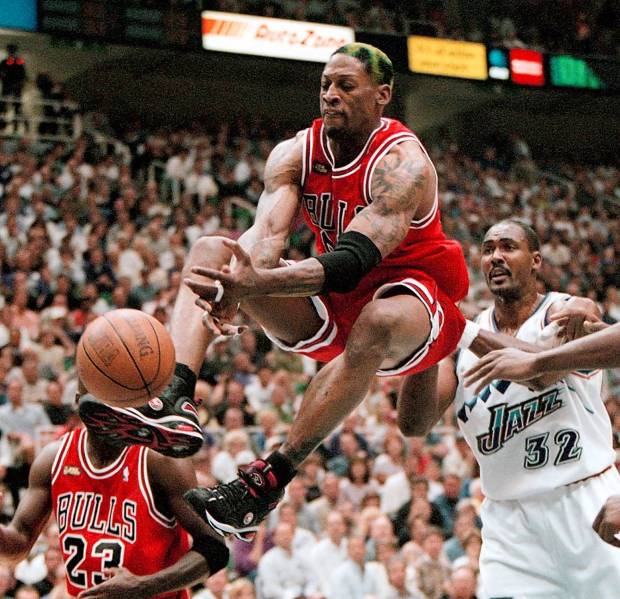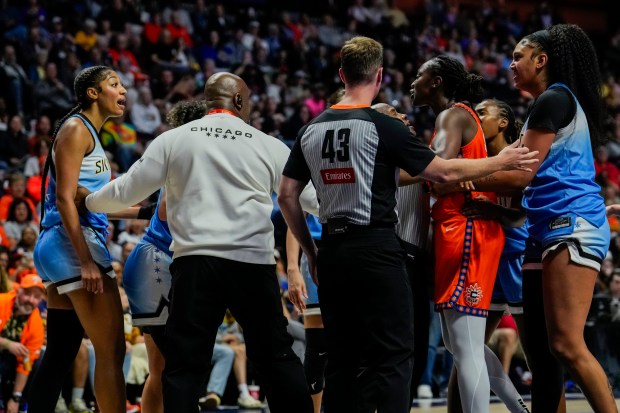Andre Drummond isn’t shy about his stature.
A four-time NBA rebounding champion, Drummond is 34th on the all-time list with 10,491 boards (12.4 per game) across his 12-year career.
And after tallying 26 rebounds for the Chicago Bulls in Wednesday’s 132-123 double-overtime win over the Cleveland Cavaliers — part of a 74-rebound night by the Bulls, the most in the NBA since 2015 — Drummond felt the performance reflected his standing among the best rebounders in league history.
“The math is very simple,” he said. “You’ve got two guys that are very good at rebounding. One of them historically being the best to ever do it — and the other one is right behind me.”
This isn’t the first time Drummond has placed himself at the top. He made the same bold claim last summer during an appearance on “The Comfortable Pod” podcast, saying: “I’m the best ever.”
And, yes, he meant better than all the greats — better than Kareem Abdul-Jabbar and Moses Malone and Wilt Chamberlain and Bill Russell and, yes, even Dennis Rodman.
In Chicago, that comparison can’t be made lightly. Rodman changed the way players viewed rebounding. His approach was both obsessive and instinctive, transforming the act of securing a missed shot into an art. He led the NBA in rebounding a record seven straight seasons from 1991-92 to 1997-98, setting a standard for rebounding in the post-merger era.
Before they became teammates in Chicago, DeMar DeRozan witnessed Drummond’s dominance on the boards firsthand as Eastern Conference foes with the Toronto Raptors and Detroit Pistons, respectively. That early education was eye-opening.
“He was a monster,” DeRozan said. “He’s been that way since he’s been in the league. They don’t make rebounders like Dre anymore. He’s so dominant with it. When you see the things that he does, it’s crazy.”
LeBron James is the only active player ahead of Drummond in career rebounds with 11,038 in 21 seasons. Drummond’s per-game average is tops for an active player and 14th all time, trailing only Rodman (13.1) among players whose careers began after 1970.
At their current averages, Drummond would surpass James within four seasons. And at age 30, Drummond likely will have extra time to pass James after the 39-year-old retires (although it’s never a safe bet that any player will outlast James).
DeRozan believes Drummond already has earned the title of the league’s best active rebounder.
The numbers this season provide a strong argument. Drummond leads the league with 18.7 rebounds per 36 minutes (adjusted for players who have played at least 100 minutes this season) — as he did last season with 18.8 per 36.
He’s fifth in the league outright with 3.5 offensive rebounds per game despite coming off the bench most of the season. And his 17.9-rebound average over his 10 starts easily would lead the league in the category.
“Nobody is equal to him in this league to be able to rebound with him,” DeRozan said.
Making the case against the greats of previous generations is a taller task. The comparisons to Rodman flowed early in Drummond’s career as he quickly established himself around the rim. It’s hard not to notice similarities when a player wears the same jerseys as a legend, so Drummond’s winding path from Detroit to Chicago has drawn a connection between the two.
Throughout his two seasons in Chicago, Drummond has pursued records Rodman set in the 1990s.
Drummond’s 17.9 rebounds per start is the most by a Bull since Rodman. He’s the third Bull ever to log multiple 25-rebound games, joining Rodman and Charles Oakley. And Wednesday’s game was his 91st with 20 or more rebounds, second in NBA history behind Rodman’s 158 since the league began keeping such records in 1982-83.
Last season Drummond came just shy of breaking Rodman’s single-season best 29.74% rebounding percentage, finishing at 29.6%. His 25.04% career percentage is tops in the league since 1970-71.
But statistics don’t tell the full story. Rodman himself is only 23rd on the all-time list with 11,954 rebounds, trailing greats such as Chamberlain, Russell and Abdul-Jabbar. Yet many fans — and perhaps most in Chicago — hail him as the greatest rebounder in league history.
Rodman was different. At 6-foot-7 he stood 4 inches shorter than Drummond, never having size as an overwhelming advantage. Instead he learned the relationship between ball and rim, then maniacally trained himself to predict the direction of a ricochet.

Bulls forward Dennis Rodman pounces for a rebound during Game 2 of the 1998 NBA Finals. (Nuccio DiNuzzo/Chicago Tribune)
His rebounding style was defined by calculation and a lack of fear, seemingly taking joy in spreading his limbs awry and launching his body parallel to the hardwood. So it’s hard to compare Rodman stylistically as a rebounder with Drummond, whose timing is aided by a massive frame and commanding presence under the rim.
Rodman left plenty of milestones to surpass. But Drummond knows his worth — and still believes he can hold down a starting job even as the center position continues to evolve in the NBA.
“I feel like history repeats itself,” Drummond said. “We’re still here. I believe I am still a starter in this league, so every time I get the opportunity, I try to showcase myself.”





